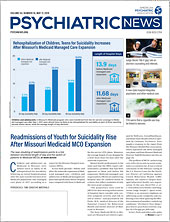Psychiatrists should consider screening patients for vaping, particularly adolescents and young adults, and offer assistance in quitting in the wake of a special announcement last month by the Food and Drug Administration (FDA) on the incidence of seizures following use of e-cigarettes.
An FDA review of voluntary adverse-event reports for e-cigarettes identified 35 cases of seizures following use of these products between 2010 and early 2019. Seizures or convulsions are known potential side effects of nicotine toxicity and have been reported following intentional or accidental swallowing of the devices’ e-liquid. In addition, some e-cigarettes deliver high concentrations of nicotine, with some containing as much nicotine as an entire pack of regular cigarettes.
“While 35 cases may not seem like much compared with the total number of people using e-cigarettes, we are nonetheless concerned by these reported cases,” wrote outgoing FDA Commissioner Scott Gottlieb, M.D., and Principal Deputy Commissioner Amy Abernethy, M.D., Ph.D., in a joint statement.
“We also recognize that not all of the cases may be reported. We believe these 35 cases warrant scientific investigation into whether there is in fact a connection.” Such seizures have been reported among first-time e-cigarette users and experienced users as well as after a few puffs or up to one day after use.
The FDA’s announcement raises questions about the safety of high-potency vaping devices and warrants further study of these products, said Douglas Ziedonis, M.D., M.P.H., associate vice chancellor for Health Sciences at the University of California, San Diego, and a professor of psychiatry at UC San Diego Health. Smokers of traditional cigarettes tend to naturally stop puffing when their blood nicotine level reaches a certain point, well before unpleasant side effects like nausea, vomiting, or, at the extreme, seizures occur from nicotine toxicity, he said.
Ziedonis said that there are many possible reasons to explain the e-cigarette-related seizures, such as nicotine poisoning from ingesting an unexpectedly high dose of nicotine, or use by an individual who was just vulnerable to seizures, or perhaps even their adding an adulterant to a vaping device, such as amphetamine or cocaine. “For psychiatrists, it’s important to screen and assess for the wide range of tobacco and nicotine-use products and to be familiar with e-cigarettes and the potential for patients to access high-dose nicotine products on the internet,” Ziedonis said. “Tobacco and nicotine products may impact the work they’re doing and affect the dosing of certain medications. It’s important to offer help for users early on to deal with tobacco or nicotine use disorders.”
The FDA’s Gottlieb and Abernethy asserted that e-cigarettes could “serve as an off-ramp for currently addicted adult smokers to completely switch to a potentially less harmful form of nicotine delivery.” At the same time, however, the pair acknowledged “tremendous concern for epidemic-level rises of youth e-cigarette use.”
The results of the 2018 National Youth Tobacco Survey showed that from 2017 to 2018, e-cigarette use rose by nearly 80% among high schoolers and 50% among middle schoolers.
Ziedonis said more action is needed, not only by the FDA, but by retailers, clinicians, parents, and teachers who need to better understand the risks of vaping so they can work together to reduce the risks for young people. “The fact that there’s such high adolescent use means we should be doing more to reduce the possibility of teens accessing these devices,” he said. ■
The FDA is asking health care professionals and the public to report any unexpected health or safety issues involving e-cigarette use
here. A free training program for psychiatrists and other health professionals who want to help their patients quit use of tobacco products can be accessed
here.

